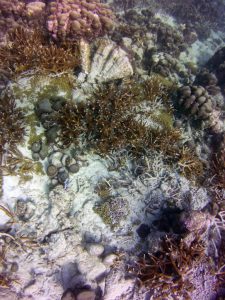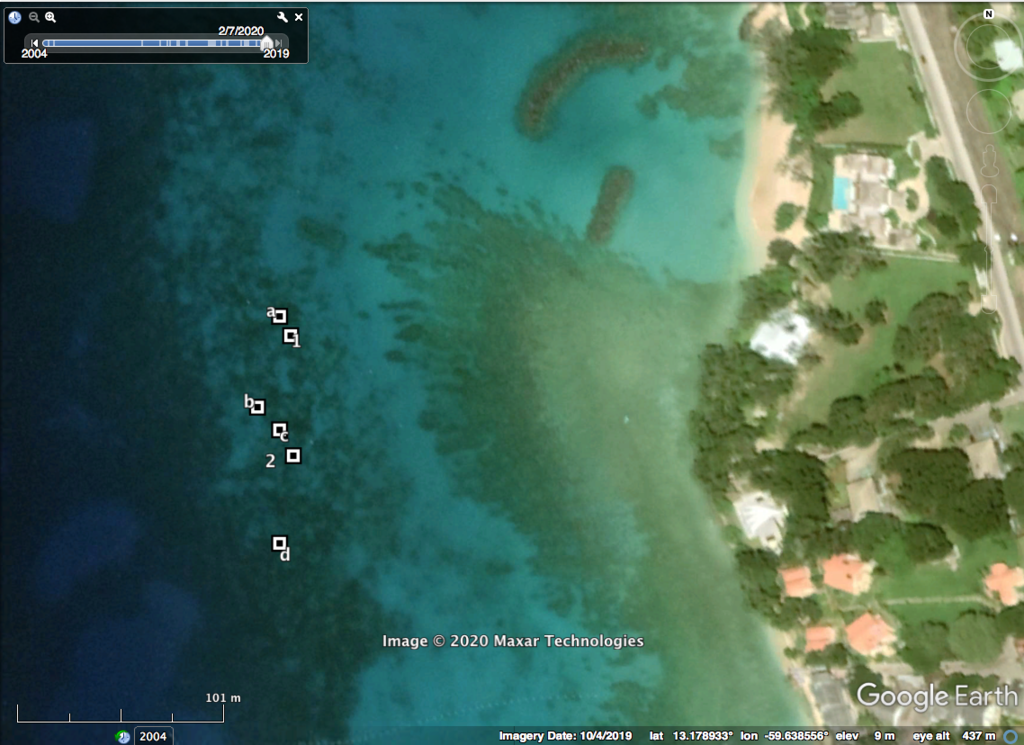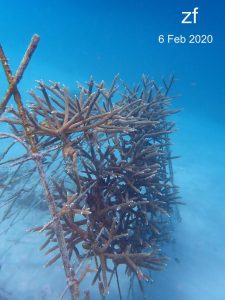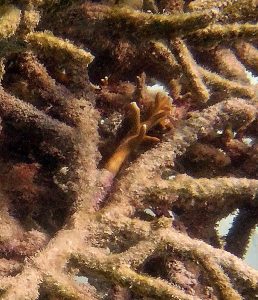CATEGORIES:
A: NATURAL STANDS (apparently) 2015-2020
B. CULTURED OR TRANSPLANTED STAGHORN CORALS IN THE VAUXHALL REEF AREA in 2020 (when first observed)
C: CULTURED OR TRANSPLANTED STAGHORN CORALS IN 2023/ALL HEALTHY
D. CULTURED OR TRANSPLANTED STAGHORN CORALS IN 2024/MOSTLY DEAD
E: NATURAL STANDS (apparently) in 2023/ALL HEALTHY (or Older dead Corals below, younger living at top)
F: NATURAL STANDS (apparently) in 2024/ALL OR MOSTLY DEAD
There are currently 14 records of A. cervicornis on the Vauxhall reef on iNaturalist. They were taken over the period 2015 – 2024 in the early months of the year (January to March or April, except in 2021 and 2022 when I did not visit Barbados). There are (apparently*) natural stands in the area, and also some cultured or transplanted specimens. In April of 2023, all stands looked healthy, but were mostly dead when first examined in Jan or Feb of 2024; presumably mortality was associated with one or more of extreme warming coral bleaching events in 2023.
I began using iNaturalist to post species records from Barbados in 2019, but these observations go back to early 2015.
*I say “apparently” because I was told verbally by one person who said she had worked with government that the “Staghorn Coral at Vauxhall was established by transplanting”, however, there appear to be no related publicly available records and what I call ‘Natural Stands’ are very similar to those I observed in the 1960s. On the other hand, nor are there, it appears, any publicly available records of what are obviously transplants or cultured corals at Vauxhall; these occur in shallower waters/sandier bottom than the ‘Natural Stands’, also on 2 pieces of wreck south of the ‘Main Wreck’. Mclean and Oxendford (2016) make no mention of artifically established A. cervicornis at Vauxhall.
The iNaturalist Records by Category
A: NATURAL STANDS (apparently) 2015-2020
A1. iNat Observation 19973672
March 7, 2015 (submitted Jan 30, 2019) 3 pics (diff. specimens), map
13.179115 -59.641450 8m accuracy
My initial report on Acroporoids at Vauxhall, which I shared at the time with government and academic personnel in Barbados, was in the form of a Google Photo album: Acropora prolifera (fused staghorn coral) in Barbados MPA 2015 and an assocated web page: Photographs of the Fringing Reef in the Recreational Zone of the Folkestone Marine Reserve, Barbados 2015-2016
A2. iNat Observation 21023591
Mar 7, 2019 (Mar 7, 2019)
Lat: 13.178586 Lon: -59.641438 Accuracy: 5m
4 photos + Location Image. Photos illustrate dense patches, some older (dead) A. cervicornis; amongst O. annularis
“Approx 25 ft depth; estimated total cover ~50m2 within a total area of approx 200 m2”
A3. iNat Observation 38388236
Apr 11, 2019 (Feb 7, 2020)
Lat: 13.179172Lon: -59.641489Accuracy: 7m
Approx. depth: 6-7 meters below MLW
Map shows locations of colonies examined 2015 (site 1) & 2019 (Site 2 Mar 7, 2019, and sites a,b,c,d on Apr 11, 2019. This record is for Site “a” [site 1]
For other sites on the Map, see these records:
Site b: https://www.inaturalist.org/observations/38388996
Site c: https://www.inaturalist.org/observations/38389034
Site d: https://www.inaturalist.org/observations/38389128
Site 1: https://www.inaturalist.org/observations/19973672
Site 2: https://www.inaturalist.org/observations/21023591
A4. iNaturalist Observation 38388996
Apr 11, 2019 (Feb 7, 2020)
Lat: 13.178794 Lon: -59.641608 Accuracy: 7m
This record is for Site “b” in map above
Approx. depth: 6-7 meters below MLW.
One pic + maps. Pic shows A cervicornis amongst Madracis asperula, O. Annularis
A5. iNaturalist Observation 38389034
Apr 11, 2019 (Feb 7, 2020)
Lat: 13.178714Lon: -59.641464Accuracy: 7m
This record is for Site “c” (map above)
Approx. depth: 6-7 meters below MLW.
One pic + maps. Pics A cervicornis amongst O. Annularis
A6. iNaturalist Observation 38389128
Apr 11, 2019 (Feb 7, 2020)
Lat: 13.178153 Lon: -59.641483 Accuracy: 7m
This record is for Site “d”
Approx. depth: 6-7 meters below MLW.
4 pics + maps. Very thick beds of A.cervicornis; some O.annularis
B. CULTURED OR TRANSPLANTED STAGHORN CORALS IN THE VAUXHALL REEF AREA in 2020 (when first observed)
B1. iNaturalist Observation 38391042
Feb 6, 2020 Feb 7, 2020
Lat: 13.1785 Lon: -59.6409 Accuracy: 10m
“Specimens apparently transplanted from adjacent natural populations in deeper water – view Map (last photo in the series, sites a,b,c,d are for natural populations, the z sites are transplants) and other entries for A. cervicornis in this project. (e.g. https://www.inaturalist.org/
observations/38388236) Some other apparently transplanted corals in the same general area are shown, some on rocks, some on a wreck. The specimens all looked firm and healthy. Approx depths 3-5 m below MLW”
6 photos, corals on A-frame, on sand, on Wreck 3
C: CULTURED OR TRANSPLANTED STAGHORN CORALS IN 2023/ALL HEALTHY
C1 iNaturalist Observation 199590436
Feb 8, 2023 (Feb 17, 2024)
Lat: 13.1785 Lon: -59.6409 Accuracy: 10m
A cervicornis grown on A frames in an open sandy area circa 5 m depth at Vauxhall Reef (Barbados) Fully healthy on Feb 8, 2023. Viewed a year later mostly dead (see next category, D, below). I believe these structures were not being maintained at this time. There were natural populations amongst Orbicella annularis in somewhat deeper water perhaps 50 m seaward. – see Category E below.
D. CULTURED OR TRANSPLANTED STAGHORN CORALS IN 2024/MOSTLY DEAD
D1. iNaturalist Observation 199551844
Feb 16, 2024 (Feb 17, 2024)
Lat: 13.1785 Lon: -59.6409 Accuracy: –
“A cervicornis propagated on frames, now 99% dead, likely associated with one or more extreme warming events in 2023. 2nd pic is closeup shoiing small branch which appears healthy. This site first observed in 2020, see https://www.inaturalist.org/
observations/38391042
D2. iNaturalist Observation 199552174
Feb 16, 2024 (Feb 16, 2024)
Lat: 13.1785 Lon: -59.6409 Accuracy: 10m
“Corals grown on frames, 99% dead, likely associated with one or more extreme warming events in 2023. Closeup photos who what appear to be new growth on pieces of the frame. See also https://www.inaturalist.org/observations/199551844 for another frame; history.
D3. iNaturalist Observation 199594149
Jan 15, 2024 Feb 17, 2024)
Lat: 13.178991 Lon: -59.641249Accuracy: 8m
“A. cervicornis colony about 6 meters depth on railing of a wreck; colony dead, overgrown with algae etc. Also shown are photos of the same site and coral on Feb 3, 2023, when it was completely healthy. This colony may have been placed there by recreational divers, poss x-planted from natural population nearby. Apparent mortality in likely associated with one or more extreme warming/coral bleaching events in 2023.”
E: NATURAL STANDS (apparently) in 2023/ALL HEALTHY (or Older dead Corals below, younger living at top)
E1. iNaturalist Observation 199597464
Mar 28, 2023
Lat: 13.178822 Lon: -59.641655 Accuracy: 12m
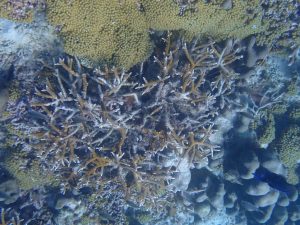 “At about 10 meters depth in Lewis’s (1960) Deep Water Communities, jusr seaward of fringing reef at Vauxhall, barbados. Amongst Madracis asperula and Orbicella annularis. Older, mostly dead coral can be seen below surface layer of mostly living A. cervicornis. This is a restricted area with A. cervicornis, not seen elsewhere at least in 2015 when Mclean & Oxendford published a report on Acroporas in Barbados “Mapping the return of acroporid corals on fringing reefs along the west coast of Barbados”
“At about 10 meters depth in Lewis’s (1960) Deep Water Communities, jusr seaward of fringing reef at Vauxhall, barbados. Amongst Madracis asperula and Orbicella annularis. Older, mostly dead coral can be seen below surface layer of mostly living A. cervicornis. This is a restricted area with A. cervicornis, not seen elsewhere at least in 2015 when Mclean & Oxendford published a report on Acroporas in Barbados “Mapping the return of acroporid corals on fringing reefs along the west coast of Barbados”
R. MACLEAN AND H.A. OXENFORD, 2016. Centre for Resource Management and Environmental Studies (CERMES), The University of the West Indies,
Cave Hill Campus, Barbados)
Photos provide 2 separate scences, and closeup (cropped photo) from each.
F: NATURAL STANDS (apparently) in 2024/ALL OR MOSTLY DEAD
F1. iNaturalist Observation 199600513
Jan 15, 2024 (Feb 17, 2024)
Lat: 13.178887 Lon: -59.64146 Accuracy: 19m
“In Lewis’s (1960) Deepwater Community, Vauxhall reef, amongst O. annularis, much of it with SCTLD. There appears to be no living A. cervicornis, in contrast to views of these communities 2015-2023, attributed to dieback associated with one or more extreme warming/coral bleaching events in 2023. Contrast with 2023 view https://www.inaturalist.org/observations/199597464”
2 pics, one a close-up from the other. A. cervicornis amongst A. annularis.
F2 . iNaturalist Observation 199601425
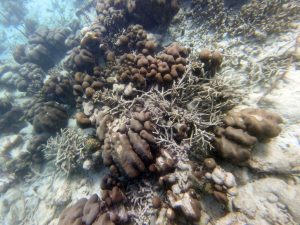
Feb 16, 2024 (Feb 17, 2024)
Lat: 13.179022 Lon: -59.641266 Accuracy: 13m
Towards inner edge of Deepwater Communities of Lewis 1960 & junction with Reef Front zone, amongst O annularis. Colonies appear completely dead, in contrast to views in early 2023; attributed to extreme warming/coral bleaching events in 2023.

